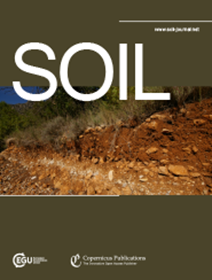利用遥感和机器学习方法减少土壤容重估算中的时间不确定性
IF 5.8
2区 农林科学
Q1 SOIL SCIENCE
引用次数: 0
摘要
摘要。土壤容重(BD)是影响土壤压实度、孔隙度和碳储量估算的关键物理性质,具有显著的时空变异性。然而,目前的BD估计方法,特别是传统的土壤传递函数(ptf),本质上是静态的,不适合时间分析。这对跨大型异质区域的土壤监测提出了重大限制。在这项研究中,我们开发了一种结合遥感数据的机器学习(ML)方法,在2004年至2009年期间在泰国全国范围内绘制和监测BD。我们使用多光谱指数、地形变量、气候数据和有机碳含量来训练6个ML模型:人工神经网络(ANN)、深度神经网络、随机森林、支持向量回归、XGBoost和LightGBM。利用2004年收集的236个土壤样品的原位BD测量来评估模型的性能。为了进行基准测试,还在同一数据集上评估了76个已发表的ptf。结果表明,人工神经网络模型预测准确率最高(R2 = 0.986;RMSE = 0.017 g cm-3),优于其他ML模型和所有ptf。利用人工神经网络模型进行的时间分析显示,2004年至2009年间,平均BD增加了7.27%,标准偏差减少了41.23%,表明土壤压实度增加,变异性减少。特征重要性分析发现有机碳、植被指数、坡度和温度是影响最大的变量。由此产生的高分辨率BD地图捕捉了国家尺度的时空趋势,为热带农业生态系统的土壤质量监测、碳核算和可持续土地利用规划提供了坚实的基础。本文章由计算机程序翻译,如有差异,请以英文原文为准。
Reducing Temporal Uncertainty in Soil Bulk Density Estimation Using Remote Sensing and Machine Learning Approaches
Abstract. Soil bulk density (BD), a key physical property affecting soil compaction, porosity, and carbon stock estimation, exhibits considerable spatial and temporal variability. However, current BD estimation methods especially traditional pedotransfer functions (PTFs) are inherently static and not designed for temporal analysis. This presents a significant limitation for soil monitoring across large and heterogeneous regions. In this study, we developed a machine learning (ML) approach integrated with remote sensing data to map and monitor BD across Thailand from 2004 to 2009 at national scale. We used multispectral indices, topographic variables, climate data, and organic carbon content to train six ML models: Artificial Neural Networks (ANN), Deep Neural Networks, Random Forest, Support Vector Regression, XGBoost, and LightGBM. Model performance was evaluated using in-situ BD measurements from 236 soil samples collected in 2004. For benchmarking purposes, 76 published PTFs were also assessed on the same dataset. Results showed that the ANN model achieved the highest prediction accuracy (R2 = 0.986; RMSE = 0.017 g cm-3), outperforming both other ML models and all PTFs. Temporal analysis using the ANN model revealed a 7.27 % increase in mean BD and a 41.23 % reduction in standard deviation between 2004 and 2009, indicating increased soil compaction and reduced variability. Feature importance analysis identified organic carbon, vegetation indices, slope, and temperature as the most influential variables. The resulting high-resolution BD maps captured national-scale spatial and temporal trends and provide a robust foundation for soil quality monitoring, carbon accounting, and sustainable land use planning in tropical agroecosystems.
求助全文
通过发布文献求助,成功后即可免费获取论文全文。
去求助
来源期刊

Soil
Agricultural and Biological Sciences-Soil Science
CiteScore
10.80
自引率
2.90%
发文量
44
审稿时长
30 weeks
期刊介绍:
SOIL is an international scientific journal dedicated to the publication and discussion of high-quality research in the field of soil system sciences.
SOIL is at the interface between the atmosphere, lithosphere, hydrosphere, and biosphere. SOIL publishes scientific research that contributes to understanding the soil system and its interaction with humans and the entire Earth system. The scope of the journal includes all topics that fall within the study of soil science as a discipline, with an emphasis on studies that integrate soil science with other sciences (hydrology, agronomy, socio-economics, health sciences, atmospheric sciences, etc.).
 求助内容:
求助内容: 应助结果提醒方式:
应助结果提醒方式:


